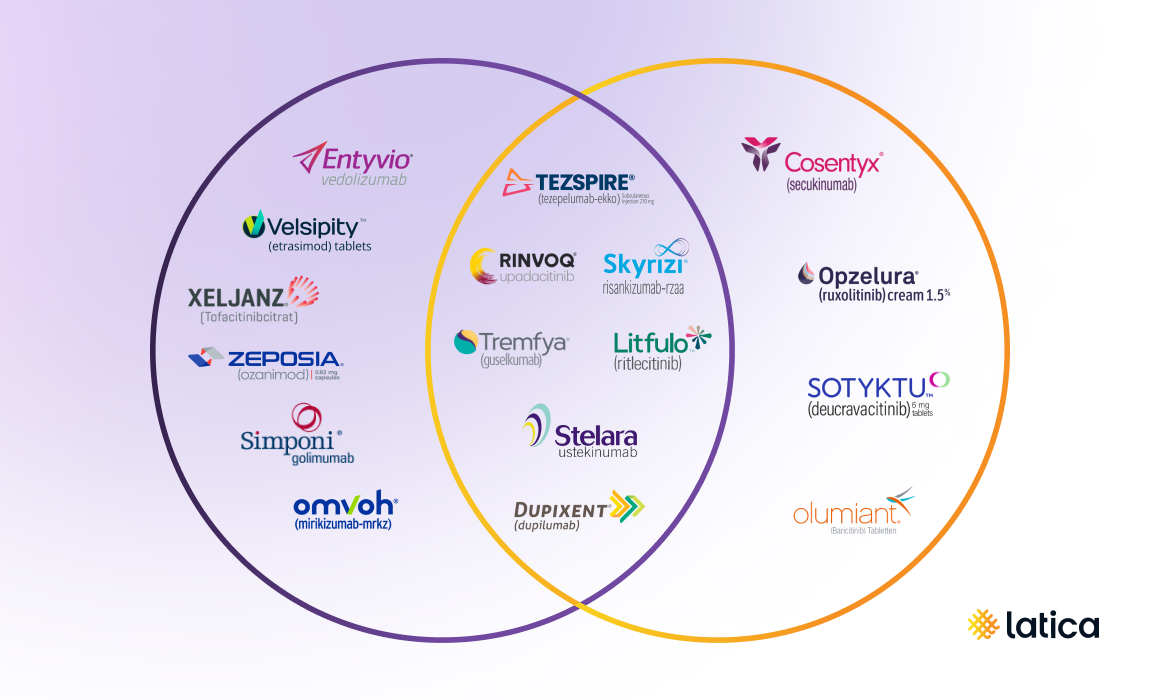Author: Collin Labar, Life Science Partnerships, Latica
Latica’s Data Network of Gastroenterology, ENT, and Dermatology connects at the center of one high impact market: Inflammation and Immunology.
Inflammation and Immunology (I&I) is at the heart of many chronic and debilitating diseases, spanning multiple healthcare verticals. These diseases are characterized by overactive or misdirected immune responses, leading to tissue damage, impaired function, and significant patient burden.
For life sciences companies, advancing I&I research is not just about innovation—it’s about transforming patient care through cutting-edge therapies powered by data-driven insights real-world evidence (RWE). At Latica, we enable this transformation by providing the tools and insights necessary to drive meaningful change in I&I research and patient outcomes.
The I&I Landscape: A Common Thread Across Verticals
From the gastrointestinal system to the skin and respiratory pathways, inflammation plays a pivotal role in disease progression. Conditions like Inflammatory Bowel Disease (IBD), psoriasis, and nasal polyps may manifest in different organs but are united by underlying immune dysregulation. This commonality has spurred the development of therapies that target shared inflammatory pathways, such as TNF-alpha inhibitors, JAK inhibitors, and interleukin (IL) modulators.
For instance:
- TNF-alpha inhibitors like infliximab (Remicade) are effective in treating Crohn’s disease, psoriasis, and even certain ENT-related autoimmune conditions
- IL-4 and IL-13 inhibitors such as dupilumab (Dupixent) have emerged as game-changers foratopic dermatitis, eosinophilic esophagitis, asthma, and nasal polyps, showcasing their versatility across dermatology, GI and ENT
This cross-vertical impact underscores the importance of comprehensive research and innovation that spans beyond disease silos.
The Role of Research and Real-World Data (RWD)
To truly transform care, life sciences companies need more than clinical trial data—they need insights from the real world. RWD, typically derived from electronic health records, claims data, patient registries, and even wearable devices, offers unparalleled opportunities to address critical gaps in I&I research.
How Latica Expands the Value of RWD:
- Unstructured Clinical Data Access: Latica ingests all unstructured data from siloed data sources (physician notes, procedure reports, biomarkers, biopsies, precision medicine testing) and maps them to the patient journey, providing an in-depth understanding of clinical outcomes and patient phenotypes.
- Comprehensive RWD Integration: By synthesizing structured and unstructured data, we provide a holistic view of patient journeys across verticals like GI, ENT, and dermatology.
- Advanced Analytics: Our cutting-edge tools uncover trends, identify treatment gaps, and support biomarker discovery, paving the way for personalized medicine in I&I.
- Accelerating Drug Development: From preclinical research to post-market surveillance, Latica enables life sciences companies to design better trials, predict outcomes, and validate therapeutic efficacy in real-world settings.
- Supporting Value-Based Care: With our RWD-driven insights, organizations can demonstrate treatment value, improve payer-provider collaboration, and optimize patient care pathways.
Use Cases of RWD for I&I Advancements
Refining Patient Understanding
I&I diseases often present heterogeneously, with symptoms and severity varying widely. For example, some IBD patients may experience mild inflammation managed with oral therapies, while others require biologics to control severe disease. RWD provides a comprehensive view of disease phenotypes, helping researchers segment patient populations for better-targeted therapies.
Improving Treatment Pathways
Real-world evidence helps identify how therapies perform outside the controlled environment of clinical trials. This is particularly critical in I&I, where patient adherence, comorbidities, and long-term outcomes are key factors in treatment success. By analyzing RWD, life sciences companies can evaluate comparative effectiveness and fine-tune treatment pathways to improve outcomes.
Enabling Precision Medicine
Precision medicine relies on biomarkers to tailor therapies to individual patients. In I&I, this could mean identifying patients more likely to respond to IL-23 inhibitors for psoriasis or selecting JAK inhibitors for refractory cases of ulcerative colitis. RWD accelerates biomarker discovery and validation, ensuring therapies reach the right patients faster.
Supporting Post-Market Research
Therapies in the I&I space, such as biologics and advanced small molecules, are among the most innovative yet costly treatments available. Payers and providers demand robust, real-world evidence to justify these investments. Post-market studies using RWD not only demonstrate a therapy’s value but also uncover new indications and long-term safety profiles.
The Future of I&I Research with Latica
The intersection of I&I research and RWD offers a promising path forward for life sciences companies:
- Shared Pathways, Shared Solutions: Cross-vertical therapies targeting inflammation offer scalable solutions for complex diseases.
- Data-Driven Innovation: RWD enables life sciences companies to identify unmet needs, improve trial design, and validate outcomes.
- Patient-Centric Care: Personalized therapies informed by real-world insights empower patients and clinicians to make better decisions.
The future of Inflammation & Immunology (I&I) research lies in breaking down data silos and leveraging real-world evidence to better understand disease heterogeneity, optimize treatment pathways, and advance precision medicine. By integrating structured and unstructured clinical data across specialties like GI, dermatology, and ENT, researchers can uncover shared inflammatory pathways, improve patient segmentation, and refine therapeutic strategies. Real-world data provides the missing link between clinical trials and everyday patient care, offering insights into long-term treatment effectiveness, biomarker validation, and post-market safety. As the field continues to evolve, harnessing these insights will be essential for developing targeted, data-driven solutions that improve outcomes for patients living with chronic inflammatory diseases.



